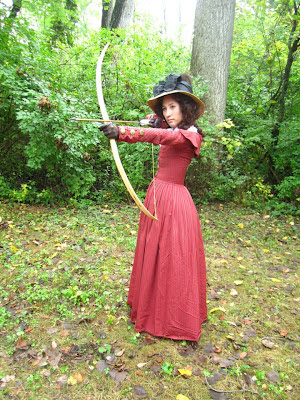One thing that I know will annoy Mike is if anyone refers to historical clothing as "costumes." I admit, I have been known to use the terms interchangeably when I'm feeling particularly lazy ("Can we go in costume?"). But there really is a difference, at least for those of us who use historical clothing as a very important (and visible) part of interpreting history. In the simplest explanation, costumes become clothing when you choose to make and wear garments based on your physical need for them, in the same way that you buy and wear clothes today. And I don't mean need as in "OMG THAT DRESS IS SO PRETTY I NEED TO MAKE IT!!!!!!". But need as in "Hmm, it's going to be 50 degrees at this event, so I want to have this, this, and this to be warm." It's picking styles and materials that would have been appropriate to the type of person you are portraying. And it's building upon existing pieces in your wardrobe, in the same way you do with your wardrobe today. It's saying "I want to wear this ribbon/petticoat/brooch/bonnet today" to change up the look of an outfit, or simply throwing on a hat and coat because you're going outside, and that's what you do.
I got a serious lesson in treating costume as clothing this summer when I worked in Colonial Williamsburg. I had essentially three outfits that comprised my wardrobe (which is barely over the minimum number of outfits most destitute poor and slaves were given, but that's an essay for another time...) so it was a fun exercise each day figuring out how to put things together differently, or add a new ribbon, or wear a different cap and kerchief combination. And it felt the same as getting dressed in 21st century clothing, when I stand in front of my closet for 20 minutes trying to figure out what to wear...
This weekend, Katie and I went to a small, local Civil War event. Neither of us wore anything new. And it actually felt
great. Of course new clothes are always fun. But there was something really rewarding to go into my closet of historical clothes and pick things out as a woman of the 1860s would, thinking "It's cold today; I need my flannel petticoat and my paletot," and "This is one of my better dresses; I want to wear it to look particularly fashionable today!" And then throwing on my trusty bonnet and gloves. I felt complete, and like a real person in real clothes, not a person in a funny costume. If you treat your historical clothing as a wardrobe, the way a person of the past would have approached their wardrobe, you come away with an invisible mindset about yourself that translates into something visible for the pubic.
Pictures from the weekend, by Katie Jacobs.












































